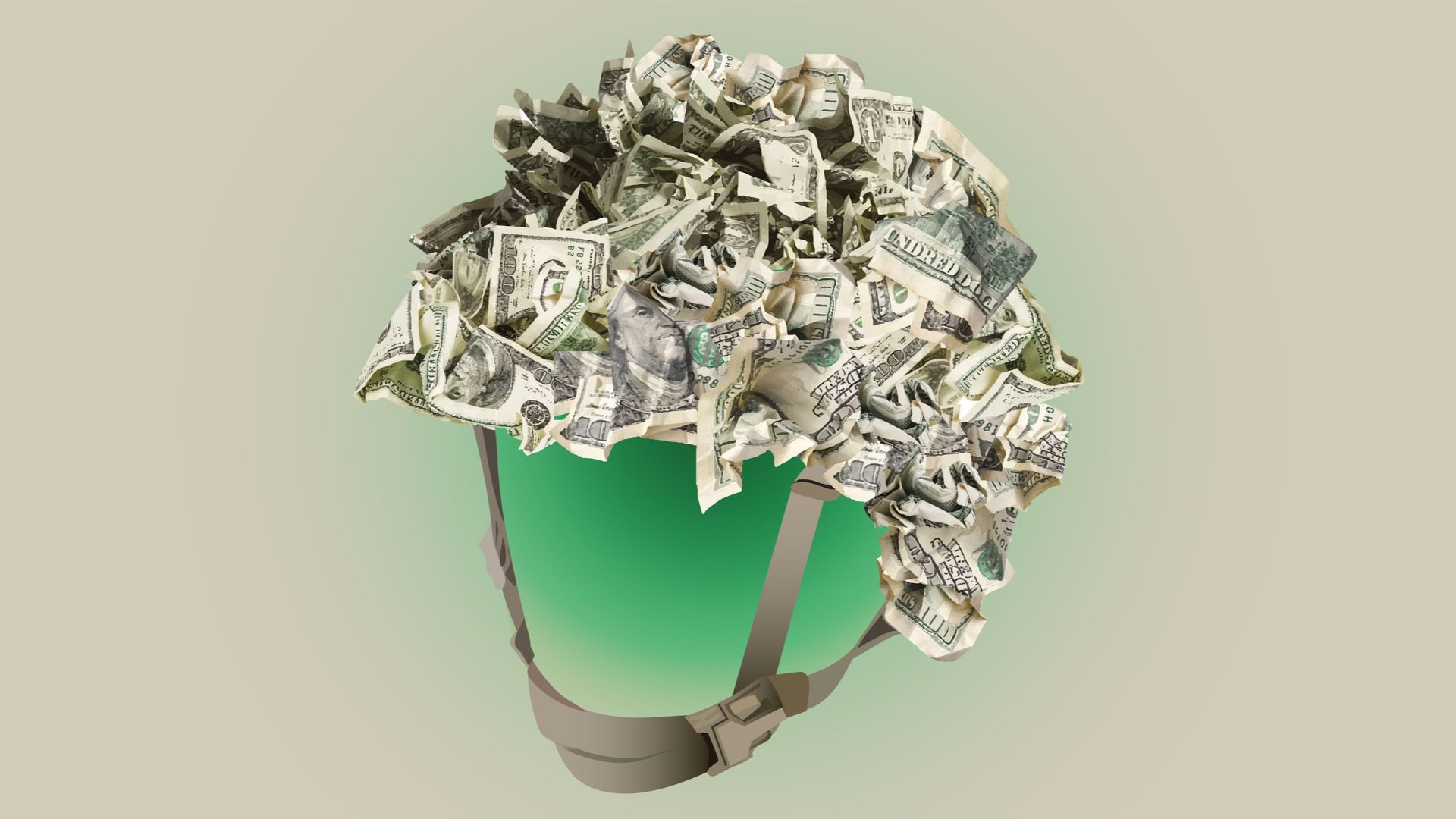尊敬的用户您好,这是来自FT中文网的温馨提示:如您对更多FT中文网的内容感兴趣,请在苹果应用商店或谷歌应用市场搜索“FT中文网”,下载FT中文网的官方应用。

How did the word “capitalism” arise? If you ask most investors that question today, they might mutter about markets, commerce and Adam Smith — or Karl Marx. But according to Michael Sonenscher, a British historian, the term actually emerged first in 18th-century Europe in connection with war finance.
“资本主义”这个词是如何产生的?如果你今天问大多数投资者这个问题,他们可能会谈到市场、商业和亚当•斯密——或者卡尔•马克思(Karl Marx)。但根据英国历史学家迈克尔•索南舍尔(Michael Sonenscher)的研究,这个词实际上最早出现在18世纪的欧洲,与战争财政有关。
“‘Capitalism’ began as a French word (capitalisme) but was used initially to refer to several largely British problems,” Sonenscher notes. “The most salient was the [18th-century] system of war finance. In French, someone who lent money to a branch of the French royal government was called a capitalist (capitaliste).”
“‘资本主义’这个词最初来源于法语单词‘capitalisme’,但它最初是用来指代一些主要与英国相关的问题。”索南舍尔指出,“其中最显著的问题是18世纪的战争财政体系。在法语中,向法国皇家政府的一个分支机构借钱的人被称为‘资本家’(capitaliste)。”
On one level, this is just an amusing quirk of history. But it should also prompt serious reflection today. In the decades after the cold war, the “peace dividend” was such that modern financiers — and voters — rarely pondered the question of how wars are paid for. This week, however, the Stockholm International Peace Research Institute reported that rising geopolitical conflict sparked a 7 per cent, inflation-adjusted, rise in defence spending last year, to a record $2.4tn, or 2.3 per cent of global economic output.
从某种程度上看,这只是历史的一个有趣的怪癖。但它也应该在今天引发我们深入的反思。在冷战结束后的几十年里,“和平红利”如此之大,以至于现代金融家和选民很少思考如何为战争买单。然而,斯德哥尔摩国际和平研究所(Stockholm International Peace Research Institute)本周报告称,由于地缘政治冲突的加剧,去年国防开支在通胀调整后增长了7%,达到了创纪录的2.4万亿美元,占全球经济产出的2.3%。
That partly reflects the impact of Russia’s invasion of Ukraine. Not only has American, European and Ukrainian expenditure jumped, but Russian military outlays have risen above 6 per cent of gross domestic product.
这部分反映了俄罗斯入侵乌克兰的影响。不仅美国、欧洲和乌克兰的军费开支大幅增加,俄罗斯的军事支出也已超过其国内生产总值的6%以上。
In fact, spending rose last year in all five geopolitical regions tracked by Sipri, for the first time. “States are prioritising military strength but they risk an action-reaction spiral in the increasingly volatile geopolitical and security landscape,” says Sipri researcher Nan Tian.
实际上,去年在国际和平研究所追踪的五个地缘政治地区的支出都有所增加,这是首次出现这种情况。国际和平研究所的研究员田楠(Nan Tian)指出:“各国正在优先考虑军事实力,但他们在日益动荡的地缘政治和安全环境中面临着行动-反应螺旋的风险。”
Rishi Sunak, UK prime minister, this week put Britain’s defence industry on a “war footing”, with expenditure slated to rise to 2.5 per cent of GDP by 2030, and Nato recently announced a $100bn spending plan. Then there are the $95bn worth of military aid bills for Ukraine, Taiwan and Israel that were just approved by the US Congress. The “action-reaction” spiral is under way.
英国首相里希•苏纳克(Rishi Sunak)本周将英国的国防工业置于“战争状态”,并计划到2030年将国防支出提升至国内生产总值(GDP)的2.5%。同时,北约最近也宣布了一项1000亿美元的支出计划。此外,美国国会(US Congress)刚刚批准了对乌克兰、台湾和以色列价值950亿美元的军事援助法案。目前,“行动-反应”的螺旋已经启动。
Thankfully, this rate of increase is still lower than at various points in the 20th century — and it comes from a low base. Sixty years ago, before the peace dividend kicked in, the US and UK respectively spent 8 and 6 per cent of GDP on the military. But given that most modern investors built their careers when “capitalism” was defined in peaceful terms, there are at least three points they should note.
幸运的是,这种增长率仍然低于20世纪的某些时期,而且是从一个较低的基数开始的。60年前,在和平红利开始产生效益之前,美国和英国分别将国内生产总值的8%和6%用于军事开支。但是,考虑到大多数现代投资者是在“资本主义”被定义为和平的时期开始他们的职业生涯的,他们至少应该注意以下三点。
First, history shows that governments almost never tell voters the true cost of war, or how they intend to pay for it. Exceptions exist. In 1940, for example, John Maynard Keynes published a clear-headed pamphlet entitled How to Pay for the War. And last year Denmark cancelled a national holiday to create additional revenue for defence outlays. In the US, political consultants are supposed to scrutinise congressional spending bills. But transparency is rare. As Sonenscher notes, the key reason why 18th-century European kings issued debt to pay for military adventures was to circumvent the scrutiny of legislatures.
首先,历史表明,政府几乎从不向选民透露战争的真实成本,或他们打算如何支付。但也有例外。例如,1940年,约翰•梅纳德•凯恩斯(John Maynard Keynes)出版了一本清晰明了的小册子,名为《如何为战争付款》。去年,丹麦取消了一个国定假日,以增加国防开支的收入。在美国,政治顾问应该审查国会的开支法案。但透明度是罕见的。正如索南舍尔所指出的,18世纪欧洲君主发行债务来支付军事冒险的关键原因是为了规避立法机构的审查。
And while the recent furore around the Ukraine bill in Congress creates a veneer of democratic oversight, “public access to budget information about . . . post-9/11 [military spending] is imperfect and incomplete”, according to a critical report from Brown University’s Watson Institute.
虽然最近国会对乌克兰法案的热议为民主监督营造了一种表象,但根据布朗大学(Brown University)沃森研究所(Watson Institute)的一份批判性报告,公众获取关于9/11后军事开支预算信息的途径仍然不完善和不全面。
The second lesson is that, even if costs are eventually wiped out via tax increases, inflation or plunder, there is usually a surge in debt. The Watson Institute estimates that in the US there has been $8tn in military outlay since 2001, which was “paid for almost entirely by borrowing”. Absent early repayment via massive tax rises, miraculous growth and/or default, “interest payments could total over $6.5tn by the 2050s”.
第二个教训是,即使通过增税、通货膨胀或掠夺最终消除了成本,债务通常也会激增。沃森研究所估计,自2001年以来,美国的军事开支已达到8万亿美元,这几乎全部是通过借款支付的。除非通过大幅增税、奇迹般的增长和/或违约来提前偿还,否则“到2050年代,利息支付总额可能超过6.5万亿美元”。
It is hard to believe that things in Europe will be any different. Yes, Sunak claimed this week that his mooted boost to military spending would be “fully funded”, via departmental spending cuts. But that sounds like magical thinking.
很难相信欧洲的情况会有所不同。是的,苏纳克本周声称,他所提出的增加军费开支的计划将通过削减部门开支来“得到充分的资金支持”。但这听起来更像是一种不切实际的想法。
Third, the shock of war not only encourages heavy state economic intervention, but financial and technological innovation, too. In 1694, for instance, the British government embraced the idea of central banking to fund war. In the 1940s, the launch of American “war bonds” helped to launch a retail market for treasuries. The second world war also led to the British and American governments developing financial repression policies. Today, experiments are being mooted to securitise the proceeds of seized Russian assets for Ukraine.
第三,战争的冲击不仅激发了国家对经济的大规模干预,也推动了金融和技术的创新。例如,1694年,英国政府采纳了中央银行的理念以筹集战争资金。在20世纪40年代,美国“战争债券”的发行助推了国债零售市场的发展。第二次世界大战还促使英美两国政府制定了金融压制政策。如今,有人正在提议将被没收的俄罗斯资产的收益进行证券化,以支援乌克兰。
Meanwhile, the US is outsourcing swaths of military tech innovation to venture capitalists. And I am told that asset managers are testing digital customisation techniques that will allow them to swiftly exclude hostile nations or regions from portfolios, while governments are unveiling new ways to track offending asset flows and assets.
与此同时,美国正在将大量军事技术创新外包给风险投资家。我得知,资产管理者正在测试数字定制技术,这将使他们能够迅速将敌对国家或地区从投资组合中排除,同时,各国政府也在推出新的方式来追踪违规资产流动和资产。
Will such innovation will continue? Probably. But what is already clear is that without huge tax rises debt issuance will keep expanding if threats of war grow. That might be defensible geopolitical “insurance” for those states fearing attack. But it will almost certainly put upward pressure on interest rates. Modern “capitalists” — aka bond holder — should take note.
这种创新会继续下去吗?很可能。但已经明确的是,如果没有大幅度的税收增长,只要战争威胁持续增加,债务发行就会继续扩大。对于那些担心遭受攻击的国家来说,这可能是一种地缘政治“保险”。但这几乎肯定会对利率产生上行压力。现代的“资本家”——也就是债券持有者——应该引起注意。